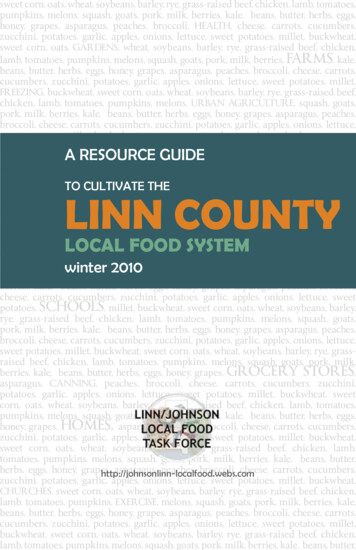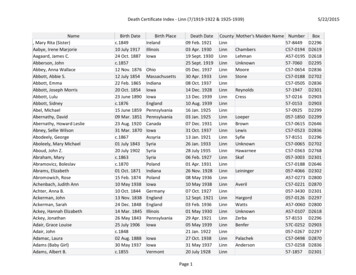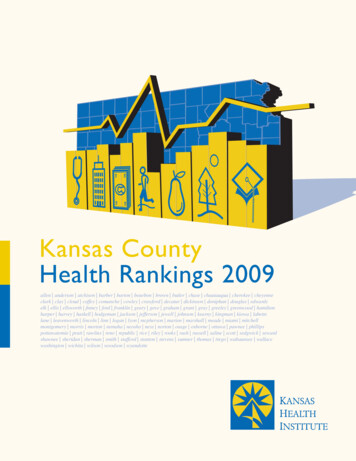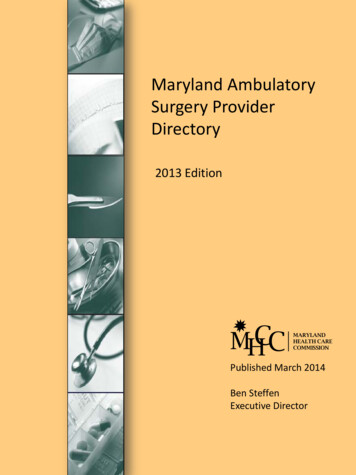
Transcription
sweet corn, oats, wheat, soybeans, barley, rye, grass-raised beef, chicken, lamb, tomatoes,pumpkins, melons, squash, goats, pork, milk, berries, kale, beans, butter, herbs, eggs,honey, grapes, asparagus, peaches, broccoli, HEALTH, cheese, carrots, cucumbers,zucchini, potatoes, garlic, apples, onions, lettuce, sweet potatoes, millet, buckwheat,sweet corn, oats, GARDENS, wheat, soybeans, barley, rye, grass-raised beef, chicken,lamb, tomatoes, pumpkins, melons, squash, goats, pork, milk, berries, FARMS, kale,beans, butter, herbs, eggs, honey, grapes, asparagus, peaches, broccoli, cheese, carrots,cucumbers, zucchini, potatoes, garlic, apples, onions, lettuce, sweet potatoes, millet,FREEZING, buckwheat, sweet corn, oats, wheat, soybeans, barley, rye, grass-raised beef,chicken, lamb, tomatoes, pumpkins, melons, URBAN AGRICULTURE, squash, goats,pork, milk, berries, kale, beans, butter, herbs, eggs, honey, grapes, asparagus, peaches,broccoli, cheese, carrots, cucumbers, zucchini, potatoes, garlic, apples, onions, lettuce,sweet potatoes, millet, buckwheat, sweet corn, oats, wheat, soybeans, barley, rye, grassraised beef, chicken, lamb, tomatoes, pumpkins, melons, squash, goats, pork, milk,berries, kale, beans, butter, herbs, eggs, honey, grapes, asparagus, peaches, broccoli,cheese, carrots, cucumbers, zucchini, potatoes, garlic, apples, onions, lettuce, sweetpotatoes, millet, buckwheat, sweet corn, oats, wheat, soybeans, barley, rye, grassTO CULTIVATETHEraised beef, chicken,lamb, tomatoes,pumpkins, melons, squash, goats, pork, milk,berries, kale, beans, butter, herbs, eggs, honey, grapes, asparagus, peaches, broccoli,cheese, carrots, cucumbers, zucchini, potatoes, garlic, apples, onions, lettuce, sweetpotatoes, millet, buckwheat, sweet corn, oats, wheat, soybeans, barley, rye, grassraised beef, chicken, lamb, tomatoes, pumpkins, melons, squash, goats, pork, milk,berries, kale, beans, butter, herbs, eggs, honey, grapes, asparagus, peaches, broccoli,cheese, carrots, cucumbers, zucchini, potatoes, garlic, apples, onions, lettuce, sweetpotatoes, millet, buckwheat, sweet corn, oats, wheat, soybeans, barley, rye, grassraised beef, chicken, lamb, tomatoes, pumpkins, melons, squash, goats, pork, milk,berries, kale, beans, butter, herbs, eggs, honey, grapes, asparagus, peaches, broccoli,cheese, carrots, cucumbers, zucchini, potatoes, garlic, apples, onions, lettuce, sweetpotatoes, SCHOOLS, millet, buckwheat, sweet corn, oats, wheat, soybeans, barley,rye, grass-raised beef, chicken, lamb, tomatoes, pumpkins, melons, squash, goats,pork, milk, berries, kale, beans, butter, herbs, eggs, honey, grapes, asparagus, peaches,broccoli, cheese, carrots, cucumbers, zucchini, potatoes, garlic, apples, onions, lettuce,sweet potatoes, millet, buckwheat, sweet corn, oats, wheat, soybeans, barley, rye, grassraised beef, chicken, lamb, tomatoes, pumpkins, melons, squash, goats, pork, milk,berries, kale, beans, butter, herbs, eggs, honey, grapes, GROCERY STORES,asparagus, CANNING, peaches, broccoli, cheese, carrots, cucumbers, zucchini,potatoes, garlic, apples, onions, lettuce, sweet potatoes, millet, buckwheat, sweetcorn, oats, wheat, soybeans, barley, rye, grass-raised beef, chicken, lamb, tomatoes,pumpkins, melons, squash, goats, pork, milk, berries, kale, beans, butter, herbs, eggs,honey, grapes, HOMES, asparagus, peaches, broccoli, cheese, carrots, cucumbers,zucchini, potatoes, garlic, apples, onions, lettuce, sweet potatoes, millet, buckwheat,sweet corn, oats, wheat, soybeans, barley, rye, grass-raised beef, chicken, lamb,tomatoes, pumpkins, melons, squash, goats, pork, milk, berries, kale, beans, butter,herbs, eggs, honey, grapes,asparagus, peaches, broccoli, cheese, carrots, chini, potatoes, garlic, apples, onions, lettuce, sweet potatoes, millet, buckwheat,CHURCHES, sweet corn, oats, wheat, soybeans, barley, rye, grass-raised beef, chicken,lamb, tomatoes, pumpkins, EXERCISE, melons, squash, goats, pork, milk, berries, kale,beans, butter, herbs, eggs, honey, grapes, asparagus, peaches, broccoli, cheese, carrots,cucumbers, zucchini, potatoes, garlic, apples, onions, lettuce, sweet potatoes, millet,buckwheat, sweet corn, oats, wheat, soybeans, barley, rye, grass-raised beef, chicken,lamb, tomatoes, pumpkins, melons, squash, goats, pork, milk, berries, kale, beans, butter,A RESOURCE GUIDELINN COUNTYLOCAL FOOD SYSTEMwinter 2010
Users of this resource guide are advised to contact individualrepresentives for details not included in the directory, such asdirections, hours, etc.The inclusion or exclusion of individials or organizations in thisdirectory is in no way an endorsement. Individuals or organizationswho would like to be included in future printings of this resourceguide should contact:Jason Grimm - Food System PlannerIowa Valley Resource Conservation and Development920 48th Ave.Amana, IA 52203Phone: (319) 622.3264Email: jason@ivrcd.orgThe information contained in this directory is believed to becorrect and accurate. However, the Linn/Johnson Local FoodTask Force and I-FOOD assumes no responsibility for producermisrepresentations of listed products, and does not assume liabilityfor any misprints, typographical errors, or other unintendedinaccuracies in content.The Linn/Johnson Local Food Task Force and I-FOOD in no wayguarantees certified organic producer compliance with the OrganicAgricultural Products law, Iowa Code Chapter 190C. Claims that aproduct was produced using “natural,” “chemical-free” or otherspecific techniques, have not been verified. Consumers shouldcontact individual producers with questions about production. TheLinn/Johnson Local Food Task Force and I-FOOD is not responsiblefor, and does not regulate or monitor, producer compliance withcounty, state, or federal health codes and licensing requirements.PLEASE NOTE:Area codes and phone numbers sometimes change with little notice.If you cannot reach a producer at the number listed, call DirectoryAssistance to see if a new number is available.Information is this resource guide is believed to be accurate, butlistings may change without notice. It is best to call ahead beforevisiting.
CONTENTSWhat Is Our Local Food System?Rebuilding Our Local Food SystemWhy? No Fresh Local Food In SchoolsLocal Food Programs & OrganizationsLocal Producers & Farmer’s MarketsResources41017222837KEY** Certified Organic* Producer indicates that “natural,” “drug-free,” “chemicalfree” or similiar production techniques were used, but productis not certified organic and therefore may not legally bemarketed as “organic.”Purchasing OptionsCSA - Offers a Community Supported Agriculture ShareDM - Directly marketed from farm/homeFM - Sold at farmer’s marketFS - Sold from farm stand not at farm/homeGS - For sale at grocery store/supermarketSR - Sold to restaurants/eateriesWS - Sold to wholesale distributorOV - Other venues for marketingUP - Go to the farm/orchard and pick your ownMZ - Enjoy a corn or haybale mazeFunds for the Linn County Local Food System Resource Guide comefrom the Regional Food Systems Working Group (RFSWG) of theIowa State University Leopold Center: Value Chain Partnershipsproject.
what is ourlocal foodsystem?
Many would agree that whenever they hear the phrase, “local foodsystem” they think of the local farmer and the vegetables they maysell at the farmer’s market. If you asked a farmer in Linn Countywhat the definition of the local food system is, they would tell youthat they are not the only players in the chain of activities thatyour food passes through from field to fork. However, the foodsystem includes butchers, millers, truck drivers, local grocers, andthe community that supports them in all their efforts (Larsen).A food system can be defined as the chain of activitiesconnecting food production, processing, distribution, marketing,access, consumption, and waste management. It includes thediverse agriculture system that produces our food, the naturalresource base and the people that live and work in the county.The food system in Linn County is a diverse and complex44%56%IN 2007 LINNCOUNTYCONSUMERS SPENT 497.2 MILLION ONFOODKen Meter: Crossroads Resource Center 537,000boughtdirectlyfromfarmers12%9%6%8%44%Ken Meter: Crossroads Resource Centerwhat is our local food system?pg 5
system that every one of us participates in. As a consumer do youconsider every other piece of the food system: the farmer in theproduction sector, the person who slaughters the pig for your hamsandwich or the garbage collector who collects your trash eachweek? Our food system is deeply integrated in our daily lives andthe activities of the communities where we live.As you read this guide you may be eating a ham sandwich witha slice of cheddar cheese on whole wheat bread. Do you knowwhat farm the pig, that your ham came from, was raised on, orthe dairy farmer that milked the cow to make the cheese on yoursandwich? The answer is probably “no,” but don’t worry becauseit is very hard to know for the average consumer. This is becausein Iowa approximately 90% of our food is imported from farmsoutside of Iowa (Tagtow). The U.S. Census of Agriculture in 2007only estimated that 537,000 was sold directly to consumers out of1,213 farms in Linn County. Linn County households spent 497.2million on food in 2007 of which 56% was on food for at home and44% on food away from home.As we purchase food we think about how we are going to prepareit. For example, when we purchase a cheese pizza we already knowthat we are going to set the oven to 425 degrees and cook the pizzafor 15-17 minutes or whatever the package says. What we don’tthink about when we purchase the pizza is what we are actuallybuying. We know the general ingredients of the pizza we boughtbut if we looked at the ingredients more closely we see many itemsthat most of cannot even pronounce.Today, we often cannot recognize the raw ingredients that makeup our food because everything is pre-made and frozen in thefreezer section of the store. Many of us could not even find theraw ingredients to make our own pizza in the grocery store andwe certainly don’t know where they came from or the farmer thatgrew and harvested the crop.In 2007, the production sector of Linn County’s food & agriculturesystem was occupied by 1,213 farms that raise beef, dairy, pork,lamb, chicken, goat, eggs, turkeys, bison, honey, corn, soybeans,oats, wheat, and fruits and vegetables. The average farmer inLinn County is 56 years old and 48% of them farm as their primaryoccupation. 90% of the primary operators of Linn County farms aremale. 145 out of the 525 female farmers in Linn County are primaryoperators of a farm. The production sector in Linn County has avery limited production system and is not highly diversified sincepg 6what is our local food system?
3%64%32%% of all farms thatproduce fruits,vegetables, honey,grains, and livestockin Linn Co.Ag. Census64% of farms in Linn County produce grains, 32% produce livestockand only 3% raise fruits, vegetables, and honey. 99.7% of theseproducts are marketed indirectly through commodity agriculturemarkets. Many would think that Linn County farmers grow a lot offood but in 1920 34 commodities were produced for sale on at least1% of all Iowa farms. Today Iowa only produces 9 commodities forsale on at least 1% of their farms. Linn County had a concentrationof apples, sweet cherries, pears, strawberries, and raspberries in1940 (Pirog).Ag. CensusOnly1 in 10 Linn County Farmers are FemaleThe food system in Linn County includes more than the localfarmers. All the things we typically think of as raw when we eatthem, for example apples and salad greens, must be washed andsorted before they can be sold. The processing and distributionsectors are often overlooked in the food system. In Linn Countythe processing infrastructure for fruits and vegetables, grains andother crops are almost gone. Today, there are only five meat &poultry processing plants in Linn County limiting a farmers abilityto process their meat for sale in Linn County. The two canneriesoperating in 1920 in Linn County are long gone (Pirog).what is our local food system?pg 7
The food system also includes the retailersin the marketing and access sector.This sector includes grocery stores,supermarkets, health food stores, foodpantries, CSA (community supportedthe average farmer is56 years old in Linn Co.48%of farmers donot work ofthe farm in ayear52%of farmersfarm at leastone day of thefarm/yearAg. Censusagriculture), food pantries and dining centers. In Linn Countythis includes HyVee, Fareway, Walmart, Target, Big Creek Market(Mt. Vernon), Whole Health (Marion), HACAP Food Reservoir sites,the Linn Community Food Bank and many other food assistancelocations.The most important part of the food system is the people inLinn Co. that make up the community. In order for there to be astrong local food system there must be a vibrant community withrespected opportunities for careers everywhere in the food system.pg 8what is our local food system?
ReferencesLarsen, Steph. “It takes a community to sustain a small farm.”Jan. 2010. Grist 7 Jan. 2010. community-to-sustain-a-small-farm.Tagtow, Angie. “A Vision for “Good Food” for Iowa.” April 2008.Environmental Nutrition Services.Pirog, Rich. “A Geography of Taste: Iowa’s Potential forDeveloping Place-based and Traditional Foods.” Ames, IA:Leopold Center for Sustainable Agriculture. 2004.what is our local food system?pg 9
rebuildingour local foodsystem
In Linn and Johnson counties multiple organizations and partnershave created a Task Force to identify issues in the Linn andJohnson local food system and develop a strategic food systemplan to address the issues. The Linn-Johnson Local Food TaskForce’s mission is to develop strategic partnerships to revitalizea local food system within the corridor. Their vision describes thecorridor as a place that embraces local foods in a diversified andenvironmentally conscious agricultural community; serving as a hubfor a revitalized regional food system.The diverse group of organizations, agencies, and communitymembers of Linn and Johnson Counties that developed the taskforce identified the need to revitalize the North Corridor as the hubof the region’s food system. The Corridor is the 2nd fastest growingregion in Iowa that is occupied by a diverse number of communitiesincluding the cities of Iowa City and Cedar Rapids. In 2007, theTask Force began researching and indentified the following issues inthe Linn and Johnson local food system.rebuilding our local food systempg 11
Top 10 Issuesidentified by the Task Forcein the Linn-Johnson Local Food System1.There are not enough local food producers.2.The industrialization of food production has destroyedthe formerly vibrant food networking and processingfacilities, as well as the social and cultural heritage ofproducing local food in the Corridor.3.Environmental concerns, such as urban sprawl and Iowa’s strongemphasis on bio fuel production, are growing pressures thatimpact local food producers, and local governmentalentities, in the Corridor negatively.4.Food insecurity, particularly among the poor, the elderly andchildren, has risen throughout the state and in the Corridor.5.Food safety is an issue of concern to Linn and Johnson Countyresidents.6.There are growing health concerns in Linn and Johnson Counties,particularly in regard to obesity (36.7% of Linn Countyresidents are classified as overweight, 28% obese, and 6.4%diabetic).7.There is limited, to no, meat processing, fruit and vegetableprocessing or dairy processing in the corridor.8.Residents surveyed supported an expanded local food system,particularly a winter farmer’s market, a more diverseselection of local food products, and an emphasison organic production.9.There is a need for more food producers, for mentoringyoung producers, and for providing producers with financialand governmental support, including efforts to improve theavailability of labor.10.An education component regarding the various benefitsof local food production is lacking.These issues are at the forefront of the mission of the Task Force.As chapter one of this guide describes, a local food system canbe defined as the chain of activities connecting food production,processing, distribution, marketing, access, consumption, andwaste management plus the diverse agriculture system thatproduces our food, the natural resource base and the people thatlive and work in the region.In the last five years there have been numerous positive changesin the Linn-Johnson local food system. From surveys of consumersit has been determined that there is an enormous demand for adiverse selection of locally grown foods year around, includingpg 12rebuilding our local food system
milk, cheese, grains, legumes, and much more. The rise of chronicdiseases and many health concerns, including obesity, have placedmore pressure on meeting the demand for healthy, locally grownfood products.Problem Statementssummarizing the issues in the local food systemIt is best to describe the problems and issues that are presenttoday in the local food system in seven problem statements thatcorrelate with the seven sectors of the food system.Problem Statement 1:The strength of the production link of the food system has asignificant effect on the other links in the chain of activities. Thelack of local food producers limits the ability to fulfill the enormousdemand for locally grown food. The lack of producers is partiallybecause there is a limited amount of social and cultural heritageof growing food today in our communities. This heritage is missingbecause of a lack of mentoring and support for beginning farmersand networking amongst the existing farmers. Continual educationand training is not easily accessible in schools or from other venues.The loss of farmland because of urban sprawl, and the high costof land prices place an enormous constraint on beginning farmers.Concern over food safety and limited processing infrastructure alsocontributes to reduce the feasibility of many local food productionenterprises.Problem Statement 2:The processing link of the food system is mostly impacted by thelack of processing infrastructure. There is limited meat, fruit andvegetable and dairy processing capacity within the Linn-Johnsonlocal food system. Concerns over food safety and the complexfood safety regulations limit the ability for small scale local foodenterprises to be feasible and profitable. The lack of knowledge offood preparation and preservation has limited the idea of a localculture that includes a diet of locally produced food.Problem Statement 3:The strength of the distribution link of the food system is highlyinterrelated with the demand, production capacity, and pricestructures of locally produced food. In the purchasing anddistribution industries in the food system budgeting processesand profit margins tremendously impact the distribution of locallyproduced food in the Linn-Johnson food system. Lastly food safetyconcerns, warehousing and quantity play a role in the distributionof locally produced food.rebuilding our local food systempg 13
Problem Statement 4:The marketing link of the food system is impacted by the enormousdemand for locally-produced foods. The minor amount of marketingof locally grown food in Linn and Johnson counties has reduced theability of consumers to identify locally grown food and to be selfempowered to search out for it in the region’s local food system.It is very important that both food insecure and food secureconsumers are educated about what is locally grown food, whereto purchase it, and how to access it. It has been difficult to marketlocally grown food without focusing on the intrinsic differences intaste and quality compared to conventional sourced food products.Problem Statement 5:The access link of the food system is impacted by the growing issueof food insecurity among the poor, elderly and children. The USDAdefines food security as a household with access by all members atall times to enough food for an active, healthy life. Food securityincludes the ready availability of nutritionally adequate and safefoods, with an assured ability to acquire acceptable foods insocially acceptable ways. One of the issues of food insecurity isthe lack of knowledge about these populations to improve theaccessibility of locally grown food. Since lack of access to healthy,locally grown food is a large problem, there are increasing healthconcerns within those populations that are food insecure.Problem statement 6:The consumption link of the food system involves the home kitchenand food eateries, and includes what type of food is consumedand how it is prepared. The consumption link of the food systemhas been highly impacted by the social and culturally acceptableforms of preparing and eating, that our society has developed inthe last 70 years. The loss of a local food culture and its traditionshas reduced the accessibility and transparency of nutrition anddiet education that is available to consumers today. The inabilityto understand and access this knowledge has diminished theability for most consumers to be able to actively regulate theirpersonal nutrition and diet. The lack of knowledge of cooking andmeal preparation has also been lost with our traditions and localfood culture. The depressing result of this new food culture is theincreasing numbers of chronic diseases and other health conditionsin addition to food insecurity.Problem statement 7:The waste management link of the food system completes theentire system and creates a closed loop. This link is usuallypg 14rebuilding our local food system
described as the three “r’s” reduce, reuse, and recycle. However,in our food system food waste is a large portion of the organicwaste stream that is not being recycled, reused, or reduced. Thisis in part because of a lack of knowledge of how to compost foodwaste and its societal acceptance. A large reason why food wasteis so large is a result of our culture’s inability to control mealportions. A result of this is a lot of food being wasted and thrownaway. As populations continue to grow and urban sprawl continuesthis issue will only become larger. Much of the possible solutionsof composting and recycling the nutrients back into the productionlink of the food system have been halted by concerns of foodsafety. Many municipalities and waste management companieshave met low thresholds that cannot be surpassed without passingthrough slow permitting processes.Goals of the Task ForceThese issues within the local food system in Linn – Johnson countiesare parallel to the issues within the regional food system. Byunderstanding and addressing these issues in Linn-Johnson counties’food system it is possible to develop the North Corridor intothe hub of the regional food system. As the 2nd fastest growingmetropolitan area in the state it will serve as the foundationof the regional food system. To achieve the development andrevitalization of the local food system in Linn and Johnson countiesthe Task Force’s goals of their strategic plan are to: Ensure the viability of existing and beginning local foodproducers and entrepreneurs that produce, process,distribute, and market products in the Linn-Johnson localfood system; Increase the availability of healthy seasonal locally grownfood in Linn and Johnson Counties; Increase the infrastructure that forms the foundation ofthe Linn-Johnson local food system; Strengthen the local food marketing campaign andensure access to healthy seasonal and affordable food forLinn and Johnson County residents; Increase the knowledge and understanding of foodpreparation and preservation amongst consumers, and; Ensure the recycling, reuse and reduction of waste asnutrients in the Linn-Johnson local food system.rebuilding our local food systempg 15
The Task Force’s objectives range from holding a workshop seriesfor both existing and beginning farmers, enabling more on-farmprocessing, establishing new marketing and sales opportunitiesfor producers and residents, establishing programs to ensurelow income families access to healthy local food, expandinglocal farmer’s markets, and holding educational sessions on safeprocessing, preserving and preparing of food.The Task Force’s vision can only be achieved through strategicpartnerships and coordinated activities. As the diagram on page 11represents local organizations and individuals form the foundationof the Task Force. Meetings allow for networking and coordinationamongst local partners so that all efforts can be strategicallyplanned together.To ensure the revitalization of the local food system within thecorridor it is important to create a vibrant and involved communityof customers that will ensure the sustainability of every componentof the local food system: bakers, farmers, millers, butchers, truckdrivers, retailers, etc.To become a partnering organization of the TaskForce contact:Jason Grimm Food System PlannerIowa Valley RC&D920 48th St. Amana, IA 52203319.622.3264 jason@ivrcd.orgFollow the Task Force’s efforts and review theirstrategic plan at their website:http://johnsonlinn-localfood.webs.compg 16rebuilding our local food system
why? No FreshLocal Food InSchoolsWhat Funds Cover the Cost for aAverage School Lunch in Iowa?
The National School Lunch Program was created in 1946 with theNational School Lunch Act. The program is administered by theUSDA Food and Nutrition Service at the Federal Level and by Stateeducation agencies at the state level. The USDA provides support inthe form of cash reimbursements for each meal served. There aremeal payment structures that children qualify for based on theirfamily income.Percentage of Students Eligiblefor Free & Reduced Meals in LinnCounty20%80%In 2009 Linn County included 19 schoolin the 2008-09 schooldistricts that were part of the nationalyear the average Iowaschool lunch program. This chapterhighlights the procurement challengesstudent paidthat school food authorities face as theyseek to purchase healthy fresh local foodfrom farmers in the region. 1.86 per lunchpg 18why? no fresh local food in schools
Cash Reimbursements Since1977 Per Lunch For Both StateAnd Federal Funding2009*The graph below demonstrates that funding for reduced257 centsprice and free lunches has gradually increased in the217 centslast 30 years compared to the minimum increase infunding for regular priced lunches.1977FederalReimbursements forFree LunchesFederalReimbursementsfor Reduced PriceLunches60 cents50 cents13.25 cents2.78 centsesFederal Reimbursements for School Lunch24 cents4 centsState Reimbursements for School Luncheswhy? no fresh local food in schoolspg 19
Regulation and Infrastructure LimitationsFood safety requirements and facility limitations challengeschool food authorities seeking to purchase and serve locallyproduced food. Food processing infrastructure is limited in theregion, so schools have to buy raw products and do the processingthemselves. Many schools do not have this equipment to processthe quantities of food needed to serve all students.Price LimitationsIn the national school lunch program every child is able to purchasea lunch from their school food authority. School food authoritiesmaintain the lowest priced school lunches possible so that everyfamily can afford to pay for a school lunch.Avg. Iowa School Lunch Price & Funding PerIncome TierInsufficient state and federal support prevent school foodauthorities from upgrading their facilities and paying for the extralabor needed to process locally produced foods without increasingthe price that families must pay for a school lunch.pg 20why? no fresh local food in schools
Potential SolutionsPotential solutions to overcoming the barriers and challenges ofpurchasing and serving of locally produced food in schools include: Increasing federal and state support so schools canupgrade facilities and increase staff in order to usemore fresh products in their meals Rebuilding local food processing infrastructure so thatfarmers can sell their products to be processed andpackaged into products that our schools can purchase Local farmers and schools working togethercooperatively to efficiently improve quality andquantity of products produced to meet the largedemands of schools Encouraging our leaders and politicians to evaluatethe current National School Lunch Program, createnew funding sources, and, potentially, create a newschool lunch program that is incorporated into everyschool day and, lastly, supporting our local farmers and schoolsin this cooperative effort because everyone wants thebest for their community and childrenwhy? no fresh local food in schoolspg 21
Local FoodPrograms &Organizations
The following organizations and programs in LinnCounty are supporters and advocates of the localfood system. Contact them for resources and ask toget involved.Linn/Johnson Local Food Task ForceMISSION OR GOALDevelop strategic partnerships to revitalize a local food systemwithin the corridor that embraces local foods in a diversified andenvironmentally conscious agricultural community; serving as a hubfor a revitalized regional food system.http://johnsonlinn-localfoods.webs.comJason Grimm Food System Plannerjason@ivrcd.org 319.622.3264Iowa Valley Regional Food Initiative (I-FOOD)MISSION OR GOALTo build a regional network of diverse people and organizations tocultivate a sustainable food system locallywww.ivfoodsystemplanning.wordpress.comJason Grimm Food System Plannerjason@ivrcd.org 319.622.3264Friends of the Cedar Rapids City MarketMISSION OR GOALThe Cedar Rapids City Market is first and foremost a meetingplace, a public space that provides the opportunity for people toencounter one another in an informal setting. A center for sociali
what is our local food system? pg 7 64% of farms in Linn County produce grains, 32% produce livestock and only 3% raise fruits, vegetables, and honey. 99.7% of these










